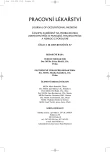Contribution to the Study of Factors Influencing the Serum Level of Aluminium in Adults
Príspevok k štúdiu faktorov ovplyvňujúcich hladinu hliníka v sére dospelých
Autori zisťovali, ako vek vplýva na obsah hliníka v sére dospelej populácie. Ďalším faktorom môže byť dialýza a trvanie dialýzy v skupine dialyzovaných pacientov. Je známe, že táto riziková skupina prevažne starších dospelých môže byť zvýšene ohrozená neprofesionálnou expozíciou hliníka.
Autori prezentujú štvorročné výsledky biologických expozičných testov obsahu hliníka v sére dialyzovaných pacientov zo 7 dialyzačných stredísk stredného a severného Slovenska. Cieľom práce bolo aj zhodnotiť mieru a pretrvávanie rizika intoxikácie hliníkom.
V rokoch 1999–2002 bolo u dialyzovaných pacientov vykonaných 445 analýz krvného séra na obsah hliníka. Priemerný vek pacientov bol 57,16± 12,07 rokov a priemerná doba expozície (roky dialýzy) bola 3,70 ± 2,41 rokov (x – ± SD). Ďalšiu skupinu tvorilo 30 dospelých vo veku 45,63 ± 7,10 rokov bez nefrologického ochorenia. Na analýzu bol použitý atomový absorpčný spektrofotometer SpectraAA s elektrotermickou termizáciou vzorky v grafitovej kyvete pri atomizačnej teplote 2700 °C.
Vyhovujúcu koncentráciu – do 2,224 μmol . l⁻¹čo je požadovaná referenčná hodnota pre dialyzovaných pacientov stanovená Komisiou Európskeho spoločenstva (KES) – malo 98 % vzoriek. Zatiaľ čo v roku 1999 presahovalo túto hodnotu 6 pacientov, v roku 2002 nebol ani jeden. Hodnoty priemerných koncentrácií hliníka v sére mali dlhodobo klesajúci charakter (0,901 ± 0,49 μmol . l⁻¹ v 1999 po 0,518 ± 0,22 μmol . l⁻¹ v 2002 – x – ± SD). V celom sledovanom období 1999–2002 boli zvýšené hodnoty hliníka nad referenčnú hodnotu KES u 8 dialyzovaných pacientov, z nich boli opakovane zaznamenané u 2 pacientov aj hodnoty hliníka nad 7,413 μmol . l⁻¹ ktoré upozornili na intoxikáciu a potrebu liečby pre vysoké depo hliníka v organizme.
Výsledky ukázali, že obsah sérového hliníka nekoreloval s vekom, ani s dĺžkou dialýzy v prípade dialyzovaných pacientov. Monitorovanie hliníka v sére dialyzovaných pacientov má opodstatnenie a môže včas zabrániť ďalšiemu závažnému poškodeniu zdravia z hliníka.
Kľúčové slová:
hliník v sére, dospelé osoby, dialyzovaní pacienti, vek, toxicita
Authors:
J. Valachová; R. Mikulková; J. Buchancová
Authors‘ workplace:
Klinika pracovného lekárstva a toxikológie JLF UK a MFN Martin
vedúci pracoviska prof. MUDr. Jana Buchancová, CSc.
Published in:
Pracov. Lék., 57, 2005, No. 3, s. 109-113.
Category:
Original Papers
Overview
The authors were studying the relationship between the age and the serum level of aluminium in the adult population. Other factors might be dialysis and the duration of dialysis in the group of dialyzed patients. It is well known that the risk group of predominantly older adults may be at risk of increased nonprofessional exposure of aluminium.
The authors present the results of biological exposure tests of an aluminium serum level in dialyzed patients from 7 dialysis centres from Central and Northern Slovakia obtained in last four years. The aim of the study was also to evaluate the rate and persistence of an aluminium intoxication risk. 445 analyses of an aluminium serum level were undertaken in dialyzed patients in the course of the period 1999–2002. The average age of patients was 57,16 ± 12,07 years and the average time of exposure (years of dialysis) was 3,70 ± 2,41 years (x – ± SD). Another group comprised 30 adults aged 45,63 ± 7,10 years without nephrological disease. The nuclear absorption spectrophotometer SpectraAA with the electrothermic thermization of the sample in a graphite shallow dish at the temperature of 2700 °C was used for analysis.
98 % samples had an adequate concentration up to 2,224 μmol . l⁻¹which is a reference value for dialyzed patients requiered by the Commission of European Community (CEC). Wereas, 6 patients exceeded this value in 1999, none of patients exceeded it in 2002. The values of average concentrations of aluminium in serum were declining in the long term run (0,901 ± 0,49 μmol . l⁻¹ in 1999, 0,518 ± 0,22 μmol . l⁻¹ in 2002 – x – ± SD). In the follow-up period 1999–2002, there were increased values of aluminium above a reference values of the CEC in 8 dialyzed patients, in 2 of the values of aluminium above 7,413 μmol . l⁻¹ were repeatedly measured and indicated the intoxication and the need of the treatment due to the high depot of aluminium in the organism.
The results did not show any correlation with age, nor the duration of dialysis in dialyzed patients. Monitoring of aluminium in serum of dialyzed patients is justified and may prevent further serious deterioration of health from aluminium.
Key words:
aluminium in serum, adults, dialyzed patients, age, toxicity
Labels
Hygiene and epidemiology Hyperbaric medicine Occupational medicineArticle was published in
Occupational Medicine

2005 Issue 3
Most read in this issue
- Arthrosis of Joints of Extremities as an Occupational Disease
- Professional Entesopathy of an Elbow Joint
- Occupational Dieseases and Endangered Occupational Diseases Notified in the Czech Republic in 2004
- Characteristics of Surface Layer of Chromium Cobalt Alloy Coated with Titanium Nitride and Zirconium Nitride
